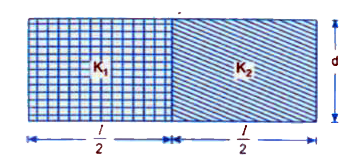Three plates A, B and C are placed close to each other with +Q charge given to the middle plate. The inner surfaces to A and C can be connected to earth through plate D and keys K1 and K2 . The plates D is a dielectric slab with dielectric constant K1 then the charge that will flow through plate D and keys K1 and K2 . The plate D is a dielectric slab with dielectric constant K , when both the keys are closed, charge that will flow through key K1 will be :
 ,
,
t(d+t)Q
d(d+t)Q
(d+t)tQ
(d+t)dQ
The correct Answer is:a
Step by step video, text & image solution for Three plates A, B and C are placed close to each other with +Q charge given to the middle plate. The inner surfaces to A and C can be connected to earth through plate D and keys K_(1) and K_(2) . The plates D is a dielectric slab with dielectric constant K_(1) then the charge that will flow through plate D and keys K_(1) and K_(2) . The plate D is a dielectric slab with dielectric constant K , when both the keys are closed, charge that will flow through key K_(1) will be : , by Physics experts to help you in doubts & scoring excellent marks in Class 12 exams.
Updated on:21/07/2023Similar Questions
If qf is the free charge on the capacitor plates and qb is the bound charge on the dielectric slab of dielectric constant k placed between the capacitor plates, then bound charge qb can be expressed as :
View SolutionTwo dielectric slabs of dielectric constants K1andK2 are filled in between the two plates, each of area A, of the parallel plate capacitor as shown in the figure. Find the net capacitance of the capacitor.

View Solution
Knowledge Check
Three plates A, B and C are placed close to each other with +Q charge given to the middle plate. The inner surfaces to A and C can be connected to earth through plate D and keys K1 and K2 . The plates D is a dielectric slab with dielectric constant K1 then the charge that will flow through plate D and keys K1 and K2 . The plate D is a dielectric slab with dielectric constant K, then the charge that will flow though plate D when K2 is closed and K2 is open is
 A−QB−Q/2CQ(1−1K)DQ2(1−1K)
A−QB−Q/2CQ(1−1K)DQ2(1−1K)A parallel plate capacitor carries a harge Q. If a dielectric slab with dielectric constant K=2 is dipped between the plates, then
Athe stored energy remains unchanged.Bthe stored energy is increased by a factor of 2.Cthe stored energy is reduced to half its previous value.Dnone of the above is correct.A capacitor of plate area A and separation d is filled with two dielectrics of dielectric constant K1=6andK2=4. New capacitance will be
 A4Aε0dB4.8Aε0dC5Aε0dD2.4Aε0d
A4Aε0dB4.8Aε0dC5Aε0dD2.4Aε0d
A parallel plate capacitor of capacitance C is charged to a potential V and then disconnected with the battery. If separation between the plates is decreased by 50% and the space between the plates is filled with a dielectric slab of dielectric constant K=10. then
View SolutionThe separation between the plates of a parallel plate capacitor is d and the area of each plate is A. iff a dielectric slab of thickness x and dielectric constant K is introduced between the plates, then the capacitance will be
View SolutionIn a parallel -plate capacitor, the plates are kept vertical. The upper half of the space between the plates is filled with a dielectric with dielectric constant K and the lower half with a dielectric with dielectri constant K and the lower half with a dielectric with dielectric constant 2K. The ratio of the charge density on the upper half of the plates to the charge density on the lower half of the plates will be equal to
View SolutionBetween the plates of a parallel plate condenser, a plate of thickness t1 and dielectric constant k1 is placed. In the rest of the space, there is another plate of thickness t2 and dielectric constant k2. The potential difference across the condenser will be
View SolutionA capacitor plates are charged by a battery with ‘V’ volts. After charging battery is disconnected and a dielectric slab with dielectric constant ‘K’ is inserted between its plates, the potential across the plates of a capacitor will become
View Solution
